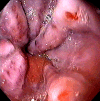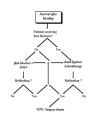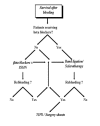Diagnosis and Treatment Algorithms of Acute Variceal Bleeding
- PMID: 30595875
- PMCID: PMC6284844
- DOI: 10.12865/CHSJ.43.03.02
Diagnosis and Treatment Algorithms of Acute Variceal Bleeding
Abstract
Esophageal varices are about 10%-15% of UGIB. Over 90% of patients with cirrhosis develop portal hypertension (PHT), but not all patients with PHT and liver cirrhosis have esophageal varices. At the time of diagnosis, only 60% of patients with cirrhosis have esophageal varices. In the case of variceal bleeding suspects, vasoactive drugs should be given as soon as possible and before endoscopy. Balloon tamponade is used to obtain temporary hemostasis by direct compression of hemorrhagic varices. The variceal band ligation is already the first place in the treatment and prevention of variceal bleeding, but also in rebleeding prevention. TIPS is used as a rescue therapy after failure of drug and endoscopic therapy. The mortality assigned to the hemorrhagic episode is substantially, estimated at 13-19% of the overall mortality in hepatic cirrhosis. Current recommendations for the treatment of acute variceal bleeding are the use of combination therapy: vasoactive drugs, balloon tamponade, elastic ligation and TIPS, whose staging is done in various diagnosis and treatment algorithms.
Keywords: endoscopy; portal hypertension; variceal bleeding.
Figures







Similar articles
-
Endoscopic diagnosis and management of esophagogastric variceal hemorrhage: European Society of Gastrointestinal Endoscopy (ESGE) Guideline.Endoscopy. 2022 Nov;54(11):1094-1120. doi: 10.1055/a-1939-4887. Epub 2022 Sep 29. Endoscopy. 2022. PMID: 36174643
-
Current approaches to the management of patients with liver cirrhosis who have acute esophageal variceal bleeding.Curr Med Res Opin. 2016;32(3):467-75. doi: 10.1185/03007995.2015.1124846. Epub 2016 Jan 25. Curr Med Res Opin. 2016. PMID: 26804426 Review.
-
Variceal and other portal hypertension related bleeding.Best Pract Res Clin Gastroenterol. 2013 Oct;27(5):649-64. doi: 10.1016/j.bpg.2013.08.004. Epub 2013 Sep 5. Best Pract Res Clin Gastroenterol. 2013. PMID: 24160925 Review.
-
Current Management of Esophageal Varices.Curr Treat Options Gastroenterol. 2003 Dec;6(6):499-507. doi: 10.1007/s11938-003-0052-3. Curr Treat Options Gastroenterol. 2003. PMID: 14585239
-
Acute variceal bleeding.Semin Respir Crit Care Med. 2012 Feb;33(1):46-54. doi: 10.1055/s-0032-1301734. Epub 2012 Mar 23. Semin Respir Crit Care Med. 2012. PMID: 22447260 Review.
Cited by
-
Neutrophil percentage-to-albumin ratio as predictor for mortality in patients undergoing endoscopic intervention for variceal hemorrhage.Eur J Med Res. 2025 Apr 26;30(1):329. doi: 10.1186/s40001-025-02489-4. Eur J Med Res. 2025. PMID: 40281590 Free PMC article.
-
Emergent Transjugular Intrahepatic Portosystemic Shunt Creation in Acute Variceal Bleeding.Semin Intervent Radiol. 2020 Mar;37(1):3-13. doi: 10.1055/s-0039-3402015. Epub 2020 Mar 4. Semin Intervent Radiol. 2020. PMID: 32139965 Free PMC article. Review.
-
Ultrarapid Development of Ruptured Esophageal Varices in a Patient With a History of Heller Myotomy.Cureus. 2024 Apr 24;16(4):e58954. doi: 10.7759/cureus.58954. eCollection 2024 Apr. Cureus. 2024. PMID: 38800322 Free PMC article.
-
Efficacy and safety of transjugular intrahepatic portosystemic shunt versus endoscopic variceal ligation for variceal rebleeding: a systematic review and meta-analysis.Ann Med Surg (Lond). 2025 Apr 2;87(5):2936-2947. doi: 10.1097/MS9.0000000000003215. eCollection 2025 May. Ann Med Surg (Lond). 2025. PMID: 40337405 Free PMC article.
References
-
- Jutabha R, Jensen DM. Management of upper gastrointestinal bleeding in the patient with chronic liver disease. Medical Clinics of North America. 1996;80(5):1035–1068. - PubMed
-
- Saftoiu A, Ciurea E. Hemoragiile digestive superioare non-variceale în gastroenterologie și hepatologie. București: Ed Medicală ; 2003. pp. 664–673.
-
- Garcia-Pagan JC, Bosch J. Medical treatment of portal hypertension. Bailliere Gastroenterol. 2000;14(6):895–909. - PubMed
-
- D'Amico G, Garcia-Tsao G, Cales P, Escorsell A, Nevens F, Cestari R. Diagnosis of portal hypertension: how and when . In: Franchis R, editor. Portal Hypertension. 3. Oxford, UK: Blackwell Science; 2001. pp. 36–64.
-
- D'Amico G, Pagliaro L, Bosch J. The treatment of portal hypertension: A meta-analytic review. Hepatology. 1995;22(1):332–354. - PubMed
Publication types
LinkOut - more resources
Full Text Sources
